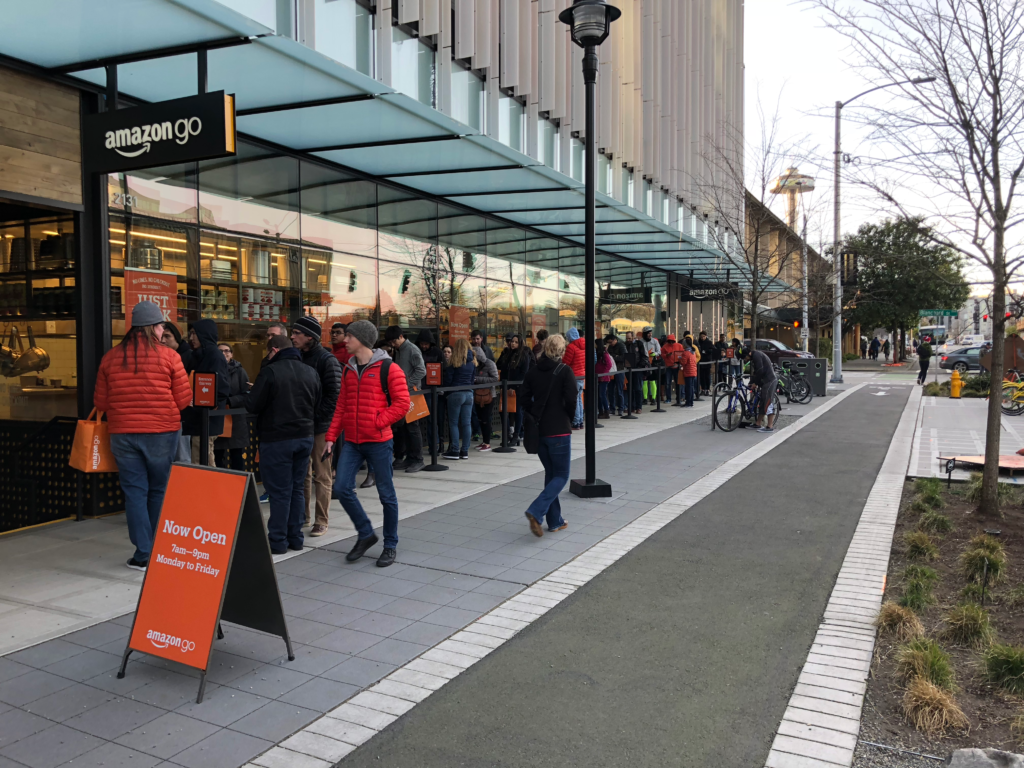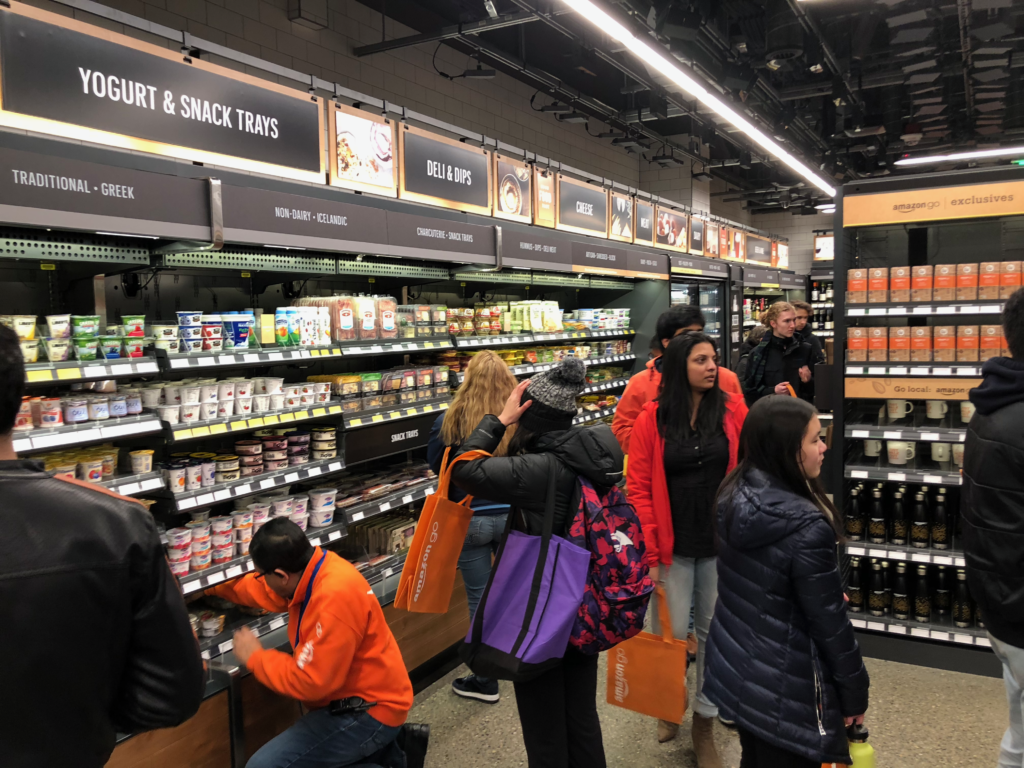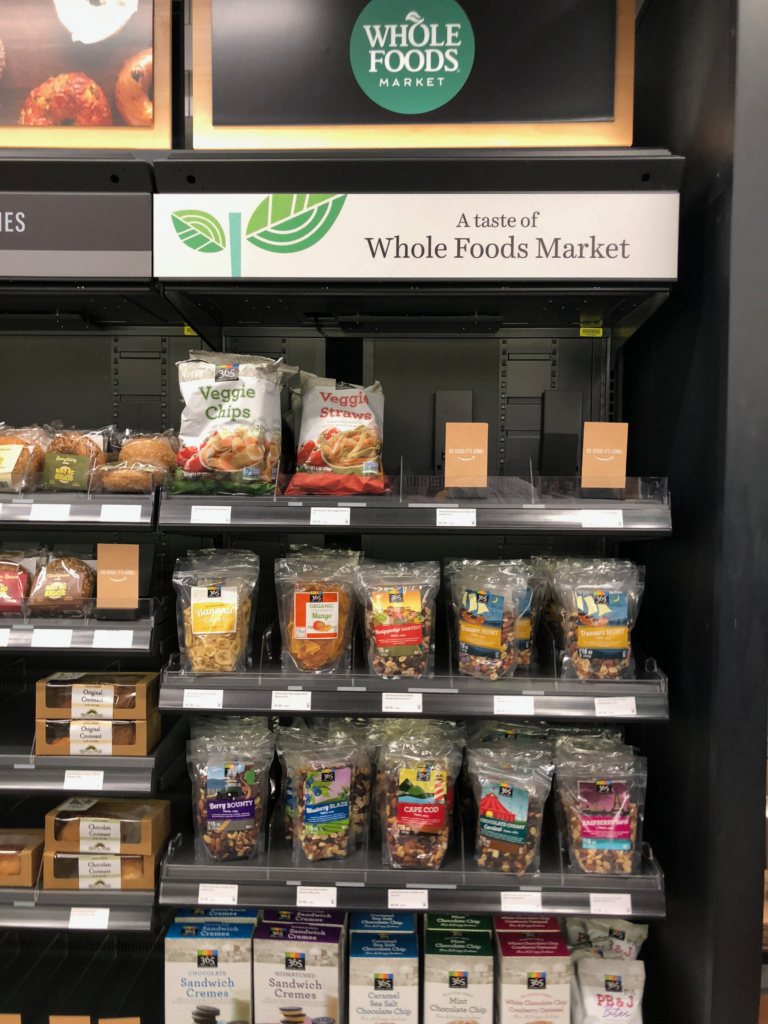I had a chance to visit the Amazon Go Store recently and wanted to speculate a bit on how it all works, from a payments perspective, and think about the implications. The new concept store, if you haven’t heard, eliminates the all-sacred checkout. Who cares about Apple Pay adoption rates or EMV transaction speed when there is no checkout? If this seems audacious, remember this is from the same company that invented one-click checkout and rode that, along with other innovations, to a $725 billion market cap.
My Store Visit
The store just opened to the public in January 2018 but has been open to employees since December 2016. It didn’t just spring from the pages of TechCrunch because its time had come. I overheard an employee telling a friend that the concept had been in development for five years inside Amazon before the store opened. I don’t know if that is true or not. But it says a lot about how far out in front of the market Amazon is in its thinking. If I was another retailer just now reading about this concept, I might be a little worried.

I arrived at roughly 5:00pm in the afternoon on President’s Day and had to wait five minutes in line to get into the store. I know, it’s crazy to wait in an entrance line for the store that has no checkout lines. But that’s not the way it is all the time. I think what I experienced that afternoon was largely “novelty” tourism. The store is new and people want to experience it. To streamline the wait, there was a greeter that distributed Amazon Go branded shopping bags, helped people download the Amazon Go app, and answered general questions about the experience. She was quick to tell everybody that if they had the app and could see the QR code, they were good to enter the store once the crowd thinned out. Fire marshall’s orders.
The Commerce Experience
Here’s what the end-user experience is like. Using the Amazon Go app, you scan the “QR code” to get in the store. There are three glass turnstiles to get in, two glass turnstiles to get out, plus a wheelchair gate that goes either way. The store itself was roughly the size of a large 1800 sq ft convenience store with a nice selection of fresh sandwiches, packaged meals, snacks, a wall of cooled drinks, a wine department, and assorted Amazon merchandise.
I bought an Amazing Go water bottle, a diet coke, and bag of Cheese snacks. There were no lines, checkout counters, or cash registers. Walking out through the glass turnstile is what triggers the payment. My receipt arrived via email about two hours later. While in the store, I wandered around, studied the setup in the store, and took a bunch of photos — but was still only there 5 minutes 4 seconds according to my receipt. Without the line to get in, and with more layout familiarity, I could see a regular customer in and out in a couple of minutes. Maybe less.
How Amazon Go works
First, the Amazon Go app is required to get in. If you don’t own a phone, haven’t installed the app, and haven’t linked it to your Amazon account you simply can’t get in the store. You can get in with somebody else as their guest, but you can’t buy anything. When you link your Amazon Go app to your Amazon account, you select one of the cards on file in your Amazon account as the default card for paying for Amazon Go purchases. It can be different from your default payment instrument used for online purchases. The app shows a 2D barcode which is scanned to open one of the turnstiles in order to enter the store. When I visited, I didn’t have the heart to tell the greeter that the QR code displayed on the screen was an Aztec code, not a QR code. Aztec is a more contemporary 2D barcode that is optimized for ticketing and facility entry. A perfect choice on Amazon’s part.
Once inside the store, Amazon watches your interaction with all the shelves. As you take things off the shelf, they are added to a virtual shopping cart associated with your Amazon account. If you put an item back, it is taken out of the virtual cart. All of this is done with cameras, assorted sensors, and the same visualization technology used by autonomous cars. The visualization system gets confused if one person takes something from a shelf and then hands it to another person. But saying it “gets confused” is not really fair. The person that takes something from a shelf simply gets charged for it when they leave regardless if they handed it to somebody else or not.

Mechanically, this is all done with hundreds of visual sensors (remember when they used to be called cameras!) that are scattered throughout the store. The sensors were spaced out in the ceiling every 18 to 24 inches and pointed towards the shelves holding the merchandise. I’ve read that there are also cameras located behind the shelves, but don’t have any reason to believe that or not believe that. Amazon also says that it uses weight sensors in the shelving to help calibrate when goods are being taken or returned to the shelves.
All the goods were arranged on a SKU-by-SKU basis. This model also worked for the hot meals that were prepared on site and packaged up ready to go. That has to make it a lot easier to detect what item is being pulled off the shelf. Goods were arranged in a very clear order on each shelf, almost in product slots. Each slot had an item description, a price, and a 2D barcode. It was not clear if the visualization system was scanning the just the item geometry, scanning the item geometry and the associated shelf barcode, scanning the barcode on the packaging itself, or scanning an embedded barcode buried inside the product packaging as a watermark. Or some combination.
It is significant that the phone is used for store entry. If the only purpose was the initial correlation of persona and account, a card swipe could do the same thing. But the app on the phone can also triangulate the location of the customer in the store and help correlate cameras to buyers. Beacon technology was hot a couple of years ago because of its ability to geolocate a device relative to a table or shelf. Perhaps this is being used here as well. There are also online articles that say individual skin tone helps the visualization system keep straight who is where inside the store. I don’t know if that is true or not.
When you walk out of the store, Amazon has been tracking the contents of your virtual cart. They do a purchase transaction using the default card that was selected and email the receipt to the buyer.

The Payments Experience
Traditionally, merchants don’t care who enters their store, as long as the person pays before they take the goods. 7-Eleven doesn’t care who I am, as long as I pay before I leave with my soda. Amazon turns this model on its head. Because there is no checkout process, all the interesting stuff happens when the customer enters the store. Amazon won’t comment on the exact payments handling technique they use or the steps they take to mitigate fraud — but we can use our experience and know-how to piece together how it might work.
First, Amazon doesn’t know how much to charge the buyer until the shopping experience is complete and the customer leaves the store. When this happens, they authorize the purchase amount and capture the transaction. But leaving the Amazon Go store is not conditionally based on receiving an authorization approval. So Amazon likely invests a fair amount of effort upon store entry to make sure the customer can plausibly pay upon store exit.
Remember that to enter the store, the customer needs to have the app, have the app linked to their Amazon account, and have the app generate a scannable barcode. The odds are good that getting the barcode to display is probably dependent on Amazon receiving an approval on a zero dollar authorization with the default payment card.
Approval tells Amazon the card is valid, the account is open, and that it is in good standing. It doesn’t guarantee there is enough money to cover the purchase cost, but it would tell Amazon that the default card could plausibly pay for the purchase upon exit. The decline of the zero dollar auth would tell Amazon the card account doesn’t exist, is closed, or has been reported stolen. Regardless of reason for the decline, Amazon would probably not generate the barcode (which is required to enter the store) if it was not approved.
Amazon would also control the timing of the zero dollar auth. The best possible time to receive approval on the authorization would be right before the customer attempts to enter the store. The authorization request could be done whenever the app is opened, but is more likely done when the app comes within the geofence that surrounds the Amazon Go store.
In my case, I installed and opened the app in San Francisco. I doubt that Amazon did a zero dollar auth when I opened the app because I was 1,000 miles away from the store. Far more likely, they did the zero dollar auth as I approached the store. I did notice while I was waiting in line that the barcode seemed to refresh. This leads me to speculate that the barcode contains not just a customer identifier, but also some indicator of when the zero dollar auth was last approved.
Our thesis then is that a good zero dollar auth gets the buyer into the store, and the actual auth and capture happens when they leave the store.
While not traditional, this model is not entirely new. This is how Netflix works. A zero dollar auth is done upon signup (to prove the subscriber is a plausibly good customer) and then the actual auth and capture every time the monthly subscription is billed. This is also how Uber works. A zero dollar auth when you order the car; actual auth and capture when the ride is complete.
Of course, there are things that could go wrong. The most common would be that while the payment card is in good standing, it doesn’t have enough available funds to cover the actual purchase amount upon exit. If this were to happen, it’s easy to anticipate that Amazon would follow up with their customer to ask for an alternative funding source. Future purchases would probably also be put on hold until the problem is cleared up. And who wants their Amazon account put on hold?
Besides the availability of funds, there are other fraud risks with this new commerce model. Presumably, a fraudster with a new Amazon account using a first-time stolen credential could scam Amazon once. After the stolen payment credential is reversed by the rightful cardholder, the Amazon account of the fraudster would be turned off and blacklisted from making future purchases on any Amazon property. While there could be other problems, it’s also important to point out that the stakes here are awfully low. The goods in the store are not criminally fenceable in the traditional sense (Pssst, hey kid, how would you like to buy a cheap diet coke?) and the fraud exposure has to be small.
As I said, we don’t know for sure if this is how Amazon handles payments and risk in the Amazon Go store. But it’s probably close to how it works and illustrates some of the techniques available to Amazon.
Glenbrook Quick Take
Amazon Go is an interesting payments use case and a profound commerce experience. It brings the frictionless Uber model to a retail setting and creates enormous levels of in-and-out convenience for consumers. The Glenbrook Seattle office reports in-and-out at lunch time is about 1:30 to 2:00 minutes. And if you’ve been to one of our Payments Boot Camps you’ll remember that our central consumer thesis is that convenience drives adoption.
From a commerce perspective, the National Retail Federation (NRF) says that inventory shrinkage and employee theft across all retail categories averaged 1.44% nationally in 2017. We suspect that a reduction in shrinkage inside the Amazon Go store (there are cameras, after all, watching every inch of the store) will more than compensate for any increase in payment fraud. We also believe that the small increase in interchange (purchases in the store are initiated as card-not-present purchases from Amazon.com) will not be material given the reduction in staffing cost inside the store.
The initial Amazon Go store is an optimized experience, for sure, designed to test and explore the feasibility of frictionless commerce in a physical retail setting. But can it work in a larger setting? Would it work in an 18,000 sq ft store? And can it work with a broader assortment of goods? We don’t know.
Here’s my challenge to you. The next time you are standing in the checkout line at Whole Foods, ask yourself whether or not you could walk out of the store if you had just scanned your way into the store. What would you be holding? How would the store be laid out? I don’t know personally if I can imagine this technology in a full-blown retail setting. Especially one that sells things by weight. But do I think I will someday shop at a Whole Foods Go store? Sure.
Let me know what you decide.





